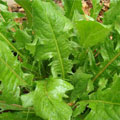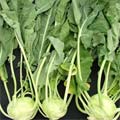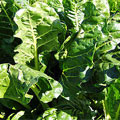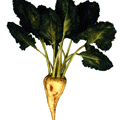Backyard Rabbit Keeping, Part 7/15 – Growing Crops for Rabbits
 It may seem to be rather an effort to set about growing crops for rabbits, but there are many advantages. Pollution from dogs, gasoline fumes and sprays makes wild food hazardous in populated areas. And then, the winter months can be difficult if you rely on wild plants because most of them are resting then. A garden can provide you with rabbit food all the year round, and not least of the advantages is vegetables for you as well. If you have a garden, you will probably already be growing most of the vegetables I suggest. If not, why not consider taking up gardening?
It may seem to be rather an effort to set about growing crops for rabbits, but there are many advantages. Pollution from dogs, gasoline fumes and sprays makes wild food hazardous in populated areas. And then, the winter months can be difficult if you rely on wild plants because most of them are resting then. A garden can provide you with rabbit food all the year round, and not least of the advantages is vegetables for you as well. If you have a garden, you will probably already be growing most of the vegetables I suggest. If not, why not consider taking up gardening?
Even in a town, you can set about acquiring a garden. There are many neglected gardens about, waiting to be looked after! Sometimes they belong to people who through age or illness are unable to continue with their gardening. Such people are often worried about their wilderness and are very pleased to come to an arrangement with someone able and enterprising. They may allow you to cultivate their garden in return for a share of the produce.
Another possibility is the allotment system. Some progressive communities have a system of providing allotment gardens in-town for people with no land; this is becoming popular again as growing vegetables becomes a necessity, and in some towns there is a waiting list of applicants.
Everyone who really wants to cultivate a piece of land should be able to find one somewhere.
Assuming, then, that we have a garden, the policy needs thinking out. Lawns can be rather a waste of space, but not if they are grazed by rabbits in Morant Hutches. So don’t dig up the lawn. If the lawn belongs to someone else and you can’t really graze it then save the lawn mowing’s for the rabbits instead.
An uncle of mine who is a professional gardener is a genius at laying out gardens in a small space. He puts vegetables and shrubs and flowers all together to make an ornamental whole. You can stroll round it all like a pleasure garden, with walks, alleys and arches contrived to make the area appear much bigger than it is, and yet tucked away among it he has a great many vegetables. So you need not dig up the roses – just grow vegetables behind them.
If you live in the country where there is plenty of rabbit food, it may not be worthwhile to grow specific rabbit crops. The waste, outside leaves and tops left over from the vegetables you and your family eat may be quite enough to see the rabbits through. The winter period is the difficult time, but root crops and winter cabbage will fill the gap.
On the other hand, town rabbits will be delighted with things like kale, comfrey or chicory and if you have room to set aside a rabbit patch, it would be well worth the trouble.
If you are a newcomer to gardening, get hold of a good book on the subject and study it from the beginning; particularly gardening with organic principles which would be useful. From the advice given by organic gardeners you will learn how valuable rabbit manure really is.
On the table of ‘possibilities’ you can see serves particularly well in multi-species gardening. I have divided these into two groups, what can be grown for the family and what can be done just as rabbit food. These all have the advantage that even the primarily human-greens will have substantial collateral material that rabbits will enjoy. Consult your local growing zones, season guides and soil condition for what will suit your area best.
| Primarily Human | Parsnips, Lettuce, Broccoli, Sprouts, Carrots, Cabbage, Cauliflower, Celery, Leek, Spinach, Jerusalem Artichoke, Beet Root, Chard, Celery, Kohl Rabi |
| Primarily Rabbit | Kale, Comfrey, Dandelion, Beet Tops, Sunflower Mangold, Kale Stem, Alfalfa, Mangold, Chicory, Pea Pods, Clippings & Mowings |
On the subject of Jerusalem Artichoke (which is related to the sunflower); they are quite hardy and do well in the north. The tubers make a good winter vegetable for you and the rabbits as well. They are almost a substitute for potatoes, although sweeter, and they have about the same food value. Artichokes contain about 14% sugar, 76% water and 3% protein. They can be boiled, and we like to roast them in the oven with the joint. Artichokes are left in the ground year after year; just dig up the tubers you want and leave a few for next year. Rabbits like the tubers, but remember to wash them before feeding. Since they are impervious to frost, a great advantage of artichokes is that they need not be taken up and stored.In the summer, artichokes put up tough, tall stems which grow like the sunflower to six feet or more. They make a good screen in the garden to keep out unwanted views or to divide it up, but they die down again when the frosts come. The young leaves are good rabbit food, and are not likely to cause scour. artichokes make a change which rabbits appreciate. The tough stems provide something for them to nibble at.
 |
Beet Root: You may not have thought of this as rabbit food, but it can be, especially if a rabbit has lost its appetite. This crop is better harvested in the autumn and stored. It can be left in the ground if you cover it with straw. |
 |
Comfrey: This is used by organic gardeners as a source of green manure; they dig it into the ground because it is high in potash. It is easy to grow once it is established as it is a perennial. You can cut it for rabbits, and let it grow again several times during the Summer. It is used a great deal in herbal medicine – ask the Henry Doubleday Research Assn. for details. |
 |
Chicory: You can find this now in some seed catalogs for use as a salad plant, to grow in pots in the dark. Chicory for rabbits can be sown in the garden in Spring, and the leaves can be cut for rabbit food about every fortnight during the Summer. The plants will carry on for years; we used to line the garden paths with it. |
 |
Dandelion: This is such a nuisance as a weed that there will probably be no need to cultivate it, but people have been known to sow an odd corner. These again are a good tonic and can be cut several times a year, but they are best fed mixed with other greens. |
 |
Kohl Rabi: This is apparently grown more in Europe than in America. It is rather like a swede, but the flavor is nutty. Eat them yourself as a root vegetable and give both roots and leaves to the rabbits. It is said that they like the green kind better than the purple. |
 |
Kale: There are various kinds of kale. Some are hardy and some are not. We have grown all the kinds on a field as well as a garden scale, but some varieties are a bit coarse for the table. This year we have curly kale in the garden and for small scale growing it beats them all. It has survived a drought and a plague of pests which killed off all the sprouts nearby, and now it is fresh and green in frost and snow. This kind of kale makes good rabbit food, and a good winter salad too, I make a variation of coleslaw with it. A disadvantage with kale is that it takes up a lot of room. The size varies according to type, but marrow stem kale plants grow to about 4ft on good land, and this kind is not frost hardy, so avoid it for the garden. If you know a farmer who grows kale for his cattle, he might be persuaded to let you have a plant or two a week for the rabbits; they will eat the lot, stem and all. On the other hand, kale is easy to grow and remarkably resistant to disease, so if you have difficulties growing cabbages and sprouts sow a row of early kale. When you thin the plants, give the thinning’s to the rabbits – this applies to all the vegetables. |
 |
Alfalfa: A legume like peas and beans. It thus has nitrogen-fixing properties which should help the garden. If you have well-drained alkaline soil, it will do Well. It is very good for animals. I once worked on a farm where we grew it for the cattle. You get three or four cuts in the Summer and it can be grown in a plot like grass and made into hay if there is any surplus. |
 |
Mangolds: These are not a table vegetable, and are usually grown for cattle and sheep. We have grown them some winters, but it involves a lot of work on a field scale. They are taken up in Autumn and stored in a clamp, an earthed-up heap to keep out the frost, ready for use in Winter. They are not properly ripe until after Christmas and if fed before then, they will scour the animals. Mangolds are resistant to pests, and they are nice succulent food when greens are scarce. They produce a large bulk from a given plot of land. So, once more, there are points for and against them. Beg them from a farmer friend if you can, but they are rather out of fashion now because of the high labor requirements. |
 |
Sugar Beet: A type of mangold grown for the sugar content which is about 1 6%. If you happen to live in a beet growing area you may find them on the roads in the Autumn, fallen from trucks on their way to the factory. Odd ones picked up like this are a welcome change for rabbit feeding. |
 |
Chard: These are much more useful than mangolds in a garden. They will provide dinners for the family as well as the rabbits, also they can stand frost, and can stay in the ground for part of the Winter at least. When you move them to dig over the plot, they should be stored under cover. The problem with growing swedes is that they are rather susceptible to plagues such as the flea beetle, but this varies according to the season. |
Herbs
These can obviously belong to the ornamental part of the garden, or be used to edge the vegetable beds. After years of neglect, herbs are popular again, and you will find them in most seed catalogues (which incidentally are full of helpful advice on gardening.) Herbs can be grown in plant pots or on window boxes if you are short of room. Grow the herbs that you are unable to find in the wild; garlic is an important one for health, and I have transplanted wild garlic from the woods successfully.
Storage
Carrots, parsnips, swedes and so on can be taken up in the Autumn and stored for the Winter. This frees the land ready for digging over for the next crop. It also keeps the roots safe from frost, which is more important with some kinds than with others. They are easier to handle and feed to the animals when stored. We cover roots with straw or sacks in a shed, or if there are a lot, as when we grow mangolds, we make them into a “pie,” covered with earth. Heaped up in sand or soil they will store well, so long as the site is not wet.
A useful trick with cabbages is to leave the stalk in the ground when you cut a cabbage; cut a cross in the top of the remaining stalk, and four small cabbages will sprout from it -not quite crisp and good enough for the table unless you are short of greens, but very good for the rabbits.
A theory which is worth some study is the one about, the compatibility of various plants. An example is planting carrots and onions together, either in alternate rows or adjacent beds, because they repel each others pests. Mint is said to keep fly away from beans, and so on.
Then there is the expanding science of biological control to study – useful creatures like hedgehogs eat insect pests, as do toads. Another aspect of organic gardening worth researching.
- Why Why Keep Rabbits?
- Rabbits Past and Present
- Some Basic Information
- Making a Start
- Housing
- Feeding
- Growing Crops for Rabbits
- Breeding
- Health
- Harvesting the Wild Rabbits
- The Harvest
- Using Rabbit Meat
- Fur Production
- Showing
- Angoras
Further Research:
   |